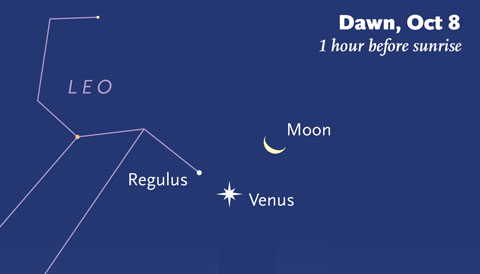Early risers will be treated to wonderful groupings of bright planets, and the evening sky offers excellent stargazing as well.
If you’re looking for planets, the eastern sky before dawn is where the action is. In fact, if you time it right, you’ve got a shot at seeing four planets plus a razor-thin crescent Moon all at once this month.

Sky & Telescope illustration
Venus leads the way. It’s the brightest planet by quite a bit, and it rises first too — around 3 a.m. or a little afterward. Jupiter pops up in the east a little later. Look a bit to Jupiter’s upper right for a medium bright star with a reddish tinge.That’s Mars. Also in the neighborhood is the bright star Regulus. Early in the month, Venus, Regulus, Mars, and Jupiter create a striking diagonal line aimed right at the point of sunrise.
In the evening, look for the Big Dipper perched low over the northern horizon. Its bowl is on the right, and its handle is sticking out toward the left. As the evening’s starry sky pinwheels through the changing seasons, the Big Dipper does a slow counterclockwise dance around Polaris, the North Star. The zigzag pattern of Cassiopeia is on the other side of Polaris.
There's lots more to see by eye in the October evening sky. To get a personally guided tour, download our 6½-minute-long stargazing podcast below.
Podcast: Play in new window | Download
Subscribe: Apple Podcasts | Google Podcasts | Spotify | Email | RSS | More
There's no better guide to what's going on in nighttime sky than the October issue of Sky & Telescope magazine.
 0
0
Comments
You must be logged in to post a comment.